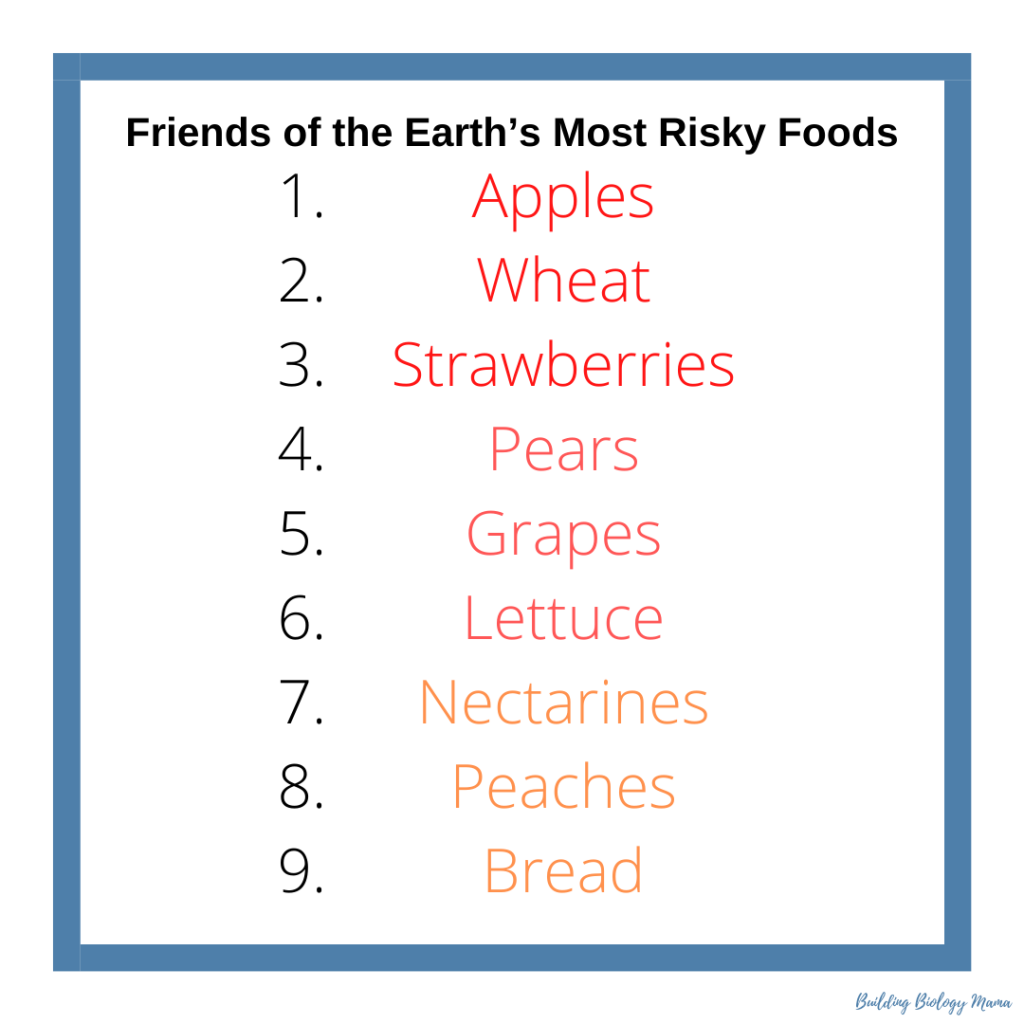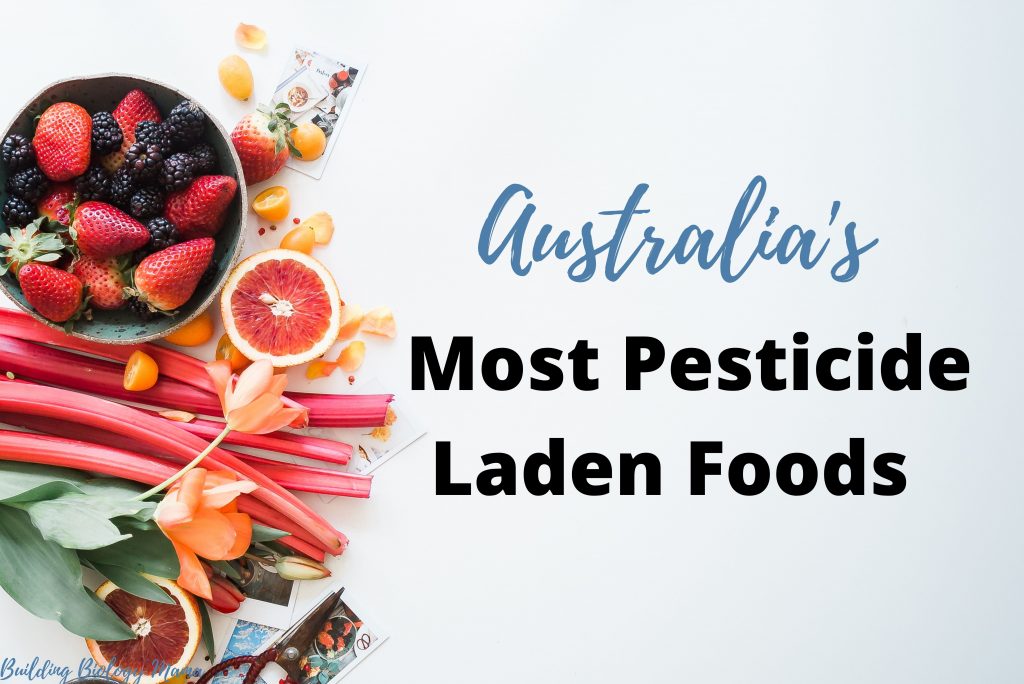Most families are conscious of income and need to budget accordingly. One question I regularly get asked is, which food is worse than others in terms of pesticide contamination.
Most families I work with want to know so they can prioritise which foods they buy organic and which foods they can be more lenient with to maximise the family budget. If this resonates with you, I highly recommend reading last week’s post I wrote titled ‘15 Ways to Eating Organic on a Budget’, however if you just want to know the worst offending foods that have the highest pesticide contamination read on.
Firstly, I encourage you to be careful of any lists you find on the internet. You see the lists easily found all over the internet about the ‘Dirty Dozen and Clean 15’ have their limitations and are not complete. In fact, they do not apply at all if you are Australian or are buying Australian food.
So this week for my fellow Aussie families, I will shed light on the Australian Worst Offenders.
The EWG’s Dirty Dozen and Clean Fifteen
American’s Environmental Working Group collates a list each revealing America’s most pesticide contaminated fruits and vegetables. This list is a highly consulted list for Americans who base their organic food purchasing on.
The EWG do not carry out testing themselves. To compile their list, the EWG reviews data collected by the USDA’s Pesticide Data Program (and FDA’s pesticide monitoring data to report on honeydew melons).
The USDA does not test each crop each year. They test items in the way people tend to consume them. For example, items with inedible peels are peeled, and those with edible peels are rinsed and scrubbed under cold water and drained before testing.
A severe limitation which everyone should be aware of is the USDA do NOT test for glyphosate (Round Up) the most heavily used pesticide in the USA!
The EWG’s Dirty Dozen needs to be interpreted with these considerations in mind.


So How Does Australian Fruits and Vegetables Compare?
Unfortunately, Australia does not test our food for all pesticides potentially sprayed on food. Nor does Australian testing test all food types across all market types.
In fact, testing of Australian food is not even coordinated between Australian states or federal government authorities.
So obtaining an informative list that resembles the EWG’s Dirty Dozen or Clean 15 for the Australian market is near impossible, except in the year of 2012.
Friends of the Earth (Australia) obtained a grant from the City of Yarra to produce an organic food guide, which outlined the main food groups most likely to contain pesticide residues. Friends of the Earth released the report titled The Dose Makes the Poison? in February 2012.
By analysing as many publicly available reports as possible, Friends of the Earth highlighted the Australian fruit and vegetables most at risk to pesticide residues and named the pesticides most commonly detected in Australian foods.
Unfortunately, what we can learn from the US Dirty Dozen list is that the list changes year to year, so please be mindful of this when reviewing the Friends of the Earth’s Most Risky Foods (these may no longer be applicable) however as it is the only list available to us, without further ado here it is…
Friends of the Earth’s Most Risky Foods

When using this list, I recommend accounting for all forms of these foods.
For example, apples top the list and therefore I suggest only buying organic apples when buying raw produce as well as applesauce, dried apples, apple juice etc.
Or when buying wheat, buy organic flour, bread, ready-made cake mixes etc. You get the idea.
Friends of the Earth’s most risky internationally sourced food over the last two years (2009-2011) was peanut butter.
Limitations of the Dirty Dozen and Most Risky Foods
Unfortunately, studies show that despite washing and peeling fruits and vegetables, due to the use of systemic pesticides, the chemicals that are in the flesh of fruit and vegetables are unable to be removed (EWG 2016).
Testing for pesticide residues are not carried out across a full range of food groups and should therefore be seen as an approximation only.
The fact that a small range of food items are tested whilst some foods are not tested at all, coupled with the fact that not all pesticides that foods are contaminated with are tested for, it is therefore, impossible to categorically state what pesticide residues are being consumed in Australia.
Why I Encourage My Clients Planning to Have a Family, Who Are Pregnant or Have Children to Buy ‘Organic’ Where They Can?
Pesticides have been linked with lower fertility, low sperm counts, birth defects, decreased birth weight, problems with brain development, autism, decreased IQ, ADHD, obesity, Type 2 diabetes, testicular cancer, thyroid disease, increased risk of developing autoimmune diseases, fatigue and drowsiness, mood changes and impaired attention, increased risk of Parkinson’s disease and a range of cancers (EWG; Friends of the Earth).
Pesticides also cross the placenta to unborn foetuses and the extent of the effects on their reproductive systems, developing organs and immune system is still unknown however “several studies show that exposure to pollutants in the womb can contribute to diseases such as cancer, immune suppression and learning disabilities later in life” (Friends of the Earth).
Children can have up to 15 times higher pesticide exposure than adults because of their diets and the American Academy of Pediatrics reports that children have a unique susceptibility to the potential toxicity of pesticide residues.
Children up to the age of seven also do not have the detoxifying enzyme to metabolise toxins meaning it stays in their body longer.
Final Thoughts
Whilst the science reveals pesticides are highly toxic and a critical toxin to try to minimise our exposure to, the good news is the science supports that our diet is one of the biggest influential factors of pesticide load for a person. This means that by eating produce and animal products free from pesticides you are getting the most value in lowering your exposure to pesticides.
Even though there are lists floating around the internet supposedly revealing which foods are the most contaminated they are all in some way flawed and incomplete.
At the end of the day pesticides contaminate our produce and decrease the health of our soils from which our produce draws its lifeforce from. Eating organic where possible is critical for your health and if budget is an issue, read last week’s post where I shared 15 Ways to Eating Organic on a Budget.
If you are planning for a family and what to maximise your health or need help transitioning your family to a life with less toxins, reach out at info@buildingbiologymama.com.au
xX Tammy
References
Environmental Working Group, 2020, EWG’s 2020 Shopper’s Guide to Pesticides in Produce, (online), Available: https://www.ewg.org/foodnews/summary.php, (date accessed January 2021).
Friends of the Earth Melbourne, 2012. The Dose Makes the Poison: Pesticides, Food and You February

Loved this blog! Will definitely be borrowing some of this awesome post.
Comprehensive! This is really wonderful post. I would definitely recommend it to others.
I read a lot of posts but the topic covered in this is the most comprehensive & helpful.
So comprehensive. Thank you for sharing this valuable information with us. This is really amazing post.
This is helpful. This is really amazing post. Thank you so much for sharing this valuable information.
Avoid calypso mangos, they are the most sprayed mangos in far North Queensland, great article.